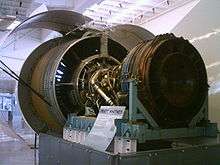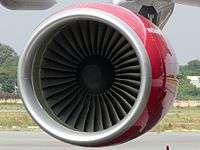Pratt & Whitney PW4000
The Pratt & Whitney PW4000 is a family of high-bypass turbofan aircraft engines produced by Pratt & Whitney as a JT9D successor. It made its first run in April 1984, was FAA certified in July 1986, and was introduced in June 1987. With thrust ranging from 50,000 to 99,040 lbf (222 to 441 kN), it is used on many wide-body airliners.
| PW4000 | |
|---|---|
.jpg) | |
| The 112 inch (2.8 m) fan diameter PW4098 used on the Boeing 777 | |
| Type | Turbofan |
| National origin | United States |
| Manufacturer | Pratt & Whitney |
| First run | April 1984[1] |
| Major applications | Airbus A300-600/A310 Airbus A330 Boeing 747-400 Boeing 767/KC-46 Boeing 777 McDonnell Douglas MD-11 |
| Produced | 1984–present |
| Number built | 2,500 (June 2017)[2] |
| Developed from | Pratt & Whitney JT9D |
| Developed into | Engine Alliance GP7000 |
Development

The 52,000-62,000lb (230-275kN), 94 in (2.4 m) -fan PW4000 made its first run in April 1984, was FAA certified in July 1986, and was introduced in June 1987. It powers the Airbus A300-600 and A310-300, Boeing 747-400 and 767-200/300, and McDonnell Douglas MD-11 widebodies.[1]
The 64,000–68,000 lbf (280–300 kN), 100 in (2.5 m)-fan version development began in December 1991 for the A330, was FAA certified in August 1993, and made its first flight two months later. It received 90min ETOPS approval at introduction in December 1994, and 180min ETOPS approval in July 1995. In January 2000, it was the A330 market leader with more than half of the installed base and one million hours, more than twice that of each competitor.[1] The Advantage70 program was launched at the 2006 Farnborough Airshow, increasing thrust to 70,000 lbf (311 kN), and reducing fuel burn by about 1% and maintenance costs by around 15%.
For the Boeing 777, the 84,000–98,000 lbf (370–440 kN), 112 in (2.8 m)-fan version development began in October 1990, achieved 100,000 lbf (440 kN) in May 1993, and was approved for 180min ETOPS at service entry in June 1995. The 90,000 lbf (400 kN) PW4090 entered service in March 1997. The 98,000 lbf (440 kN) PW4098 received FAA certification in July 1998 and introduced on the Boeing 777-300 in September 1999.[1] The 777 launch engine, it entered service on June 7, 1995, with United Airlines.
In 2000, over 2,000 PW4000 engines had accumulated over 40 million hours of service with 75 operators.[1] In 30 years between June 1987 and 2017, more than 2,500 engines have been delivered, logging more than 135 million flight hours.[2]
Design
Single-crystal alloys allows higher temperature capability and PW's Floatwall combustor liners improve durability and maintainability. The Talon ("Technology for Affordable Low NOx") single-row combustor improves fuel-air mixing, for over 10% better NOx, CO, and HC emissions. It was approved for 180min Extended-range Twin-engine Operations (ETOPS) and has a dispatch reliability rate of 99.96%. The average engine stays on wing 13,500 flight hours before a shop visit (a Shop Visit Rate of 0.073 per thousand hours). The PW4000 is up to 1.7 to 3.4 dB (cumulative) quieter than competitors.[1]
It has a Full Authority Digital Engine Control (FADEC), for better fuel economy and reliability.[3]
Variants and applications
%2C_Aeromexico_JP6079092.jpg)

.jpg)
PW4000-94
Thrust range: 231–276 kN (52,000 lbf – 62,000 lbf)[4]
- Airbus A300-600
- Airbus A310-300
- Boeing 747-400 (and Scaled Composites Stratolaunch)
- Boeing 767-200/-300(Including ER Version and Boeing Converted Freighter version except -300F)/-2C/Boeing KC-46A
- McDonnell Douglas MD-11
PW4000-112
Thrust range: 329–436 kN (74,000 lbf – 98,000 lbf)[6]
- Boeing 777-200(except -200LR)/-300(except -300ER)
Specifications
The PW4000 is produced in three distinct models, with differing LP systems to address different thrust needs.
| Variant | -94[7] | -100[8] | -112[9] | |
|---|---|---|---|---|
| Type | Two spool high bypass ratio Turbofan | |||
| Length | 153.6 in (390 cm) | 167.2 in (425 cm) | 190.4 in (484 cm) | |
| Weight | 9,420 lb 4,273 kg |
12,900 lb 5,851 kg |
15,095–15,741 lb 6,847–7,140 kg |
16,260 lb 7,375 kg |
| Compressor | 1 fan, 4 LP, 11 HP | 1 fan, 5 LP, 11 HP | 1 fan, 6 LP, 11 HP | 1 fan, 7 LP, 11 HP |
| Combustor | Annular | |||
| Turbine | 2 HP, 4 LP | 2 HP, 5 LP | 2 HP, 7 LP | |
| Thrust | 50,000–62,000 lbf 222–276 kN |
64,500–70,000 lbf 287–311 kN |
77,440–91,790 lbf 344–408 kN |
91,790–99,040 lbf 408–441 kN |
| Variant | -94[10] | -100[11] | -112[12] | |
| Fan | 94 in (239 cm) | 100 in (254 cm) | 112 in (284 cm) | |
| Bypass ratio | 4.8-5:1 | 4.9:1 | 5.8-6.4:1 | |
| Overall pressure ratio | 27.5-32.3 | 32.0-34.1 | 34.2-42.8 | |
| Fan pressure ratio | 1.65-1.80 | 1.75-1.76 | 1.70-1.80 | |
| Applications | B747-400, B767, MD-11 A300-600, A310 |
A330 | B777 | |
See also
Related development
Comparable engines
- General Electric CF6
- General Electric GE90
- Pratt & Whitney PW2000
- Progress D-18T
- Rolls-Royce RB211
- Rolls-Royce Trent
Related lists
References
- "PW4000 derivatives continue to drive engine success story". Flight Daily News. 23 February 2000.
- "Pratt & Whitney Commemorates 30 Years of PW4000-94 Engine Power" (Press release). Pratt & Whitney. 21 June 2017.
- Jeff Schweitzer, Pratt & Whitney (14–17 July 2003). "Propulsion Technology Readiness for Next Generation Transport Systems". AIAA International Air and Space Symposium and Exposition. doi:10.2514/6.2003-2787.
- Pratt & Whitney. "PW4000-94". Retrieved 20 July 2019.
- Pratt & Whitney. "PW4000-100". Retrieved 20 July 2019.
- Pratt & Whitney. "PW4000-112". Retrieved 20 July 2019.
- "TCDS E24NE" (PDF). FAA. 23 November 2015.
- "TCDS E36NE" (PDF). FAA. 28 May 2014.
- "TCDS E46NE" (PDF). FAA. 23 January 2012.
- "PW4000 94-inch-fan" (PDF). Pratt & Whitney.
- "PW4170 Engine for the A330" (PDF). Pratt & Whitney.
- "PW4000 112-inch-fan" (PDF). Pratt & Whitney.
Further reading
| Wikimedia Commons has media related to Pratt & Whitney PW4000. |
- PW4000-94 Product Page
- PW4000-100 Product Page
- PW4000-112 Product Page
- Gunston, Bill (2006). World Encyclopedia of Aero Engines, 5th Edition. Phoenix Mill, Gloucestershire, England, UK: Sutton Publishing Limited. ISBN 0-7509-4479-X.